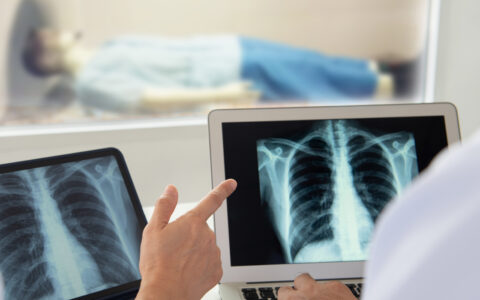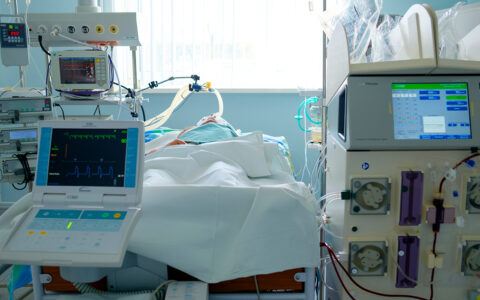Lowering acute rejection risk by mitigating immune overreaction has been a central focus in efforts to improve outcomes for lung-transplant patients.
But with infections the leading cause of death for recipients between one month and one year post-transplant, questions linger over how best to equip immunosuppressed patients to resist illness and avoid serious complications, such as chronic lung allograft dysfunction (CLAD).
At Vanderbilt University Medical Center, where 94 lung transplants were performed in 2023, transplant pulmonologist Anil J. Trindade, M.D. is seeking ways to improve patient outcomes following lung transplantation.
“To date, no trials in lung allograft recipients have evaluated two high doses within the same influenza season as a strategy to improve immunogenicity and durability of influenza prevention.”
“Homeostasis is key to a successful transplantation,” Trindade said. “To protect the patient’s lungs, they need to avoid allograft rejection, while having sufficient immunity to avoid and fight infectious pathogens.”
Meanwhile, a separate trial to examine optimal management and storage conditions for donor lungs is underway, co-led by Trindade and Matthew Bacchetta, M.D., Vanderbilt’s lung transplant medical director.
Standard of care for lungs has been storage at 4C. However, a 2023 study that compared historic controls with cold-static preservation at 10C over up to 14 hours found greater safety as well as potential logistical and performance benefits using the warmer temperature.
“If we have a longer window before transplant, we can avoid late-night surgeries, when hospital staffing in most hospitals is suboptimal,” Trindade said.
High-Dose Vaccine Trial
Influenza is among the most common infectious threats to the lung-transplant population. Most lung transplantation patients receive a standard dose of influenza vaccine, yet Trindade says that this may be insufficient.
While other groups have compared the standard dose to the high dose in solid-organ recipient, or compared two standard doses in a single flu season to just one, more research is needed to determine the optimal regimen, Trindade explained.
“Certainly, what we learn from using higher amounts of antigen exposure to elicit a response is going to be applicable to other vaccines.”
An NIH U01 grant awarded to Vanderbilt infectious disease specialist Natasha Halasa, M.D., M.P.H., will examine infection threats to solid organ recipients across five transplant centers in the United States. Trindade serves as the site investigator at Vanderbilt.
This phase 2 randomized, double-blinded trial is seeking to determine whether stronger vaccine doses and greater dose frequency can improve responses in liver, kidney and heart recipients. The research team will also be considering ways to optimize dosing in the lung transplant-specific sub-population.
The researchers will recruit 270 patients ages 16 or older who will be randomized to two groups: one will receive two standard-strength vaccine doses and the other group will receive two higher-dose vaccinations per flu season. Participants will be followed for up to 35 months post-transplant for evaluation of safety and tolerability, volume of antigen production, and rates of acute cellular rejection and antibody-mediated rejection.
In addition, Halasa has further received NIH funding to compare high-dose versus standard-dose influenza vaccine in pediatric solid-organ transplant recipients through a smaller, phase 1 trial involving lung recipients.
“To date, no trials in lung allograft recipients have evaluated two high doses within the same influenza season as a strategy to improve immunogenicity and durability of influenza prevention,” Trindade said. “While there are some studies on other allograft recipients, extrapolation is limited, since lung transplant patients receive the highest immunosuppression intensity of all transplantation patients.”
Influenza poses a mortality risk to transplant recipients, as well as complications, such as pneumonitis, he said.
“In some patients the resultant lung injury can be severe enough that intubation and mechanical ventilation are required. Influenza can also precipitate acute cellular rejection, antibody-mediated rejection, and potentially chronic lung allograft dysfunction.
“Certainly, what we learn from using higher amounts of antigen exposure to elicit a response is going to be applicable to other vaccines.”
Six Degrees to Healthier Mitochondria
Trindade said previous animal studies have demonstrated lung preservation at 10C is associated with an improved inflammatory profile, improved mitochondrial health, and maintenance of cellular membrane function.
“If the colder temperature slows down metabolism and the potentially protective anti-inflammatory processes then, once the lungs are implanted, the ability to fight infection and fight other inflammatory danger signals might be decreased,” Trindade said.
“That’s important, because about a third of our patients are at risk for primary graft dysfunction, a massive inflammatory response, within the first few days of presentation.”
Trindade will serve as site investigator on the first prospective, randomized, controlled trial to compare the two storage methods. The researchers will assess results for primary graft dysfunction, grading the severity of primary deficits by looking at inflammation on chest X-rays and the P/F ratio, a measure of the gas exchange system.
“The question will be, ‘What’s the degree of inflammation within those first 72 hours post-transplant when these inflammatory cascades occur?’” Trindade said. “We will then be looking at longer-term outcomes like 30-day survival and graft function.”




